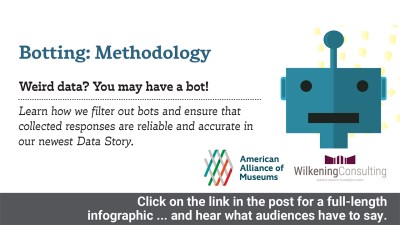Previous mid-year updates on social entrepreneurship, big data and the sharing economy were pretty text heavy. As a bit of relief from all that reading, I’m going to go with very short text this week, and give the bulk of the update via video.
(Remember you can download a free PDF copy of TrendsWatch 2014 from the web, a free app version (with embedded videos) from the iTunes store, and purchase print copies from the AAM Bookstore.)
Enjoy!
Notable developments
- A recent poll of experts by the Pew Research Internet Project showed that nearly half expect a future in which robots and digital agents (such as the artificial intelligence Watson created by IBM) displace significant numbers of blue- and white-collar workers.
- Ethicists and judicial scholars are speculating whether robots, like corporations, should have rights and obligations, while the United Nations debates what boundaries need to be placed on robotic warfare
- The past few months have seen articles on robot security guards; on the effect of increasingly sophisticated robots and AI on professions like lawyer, doctor and architects; and on robots that can assemble themselves.
- The debate rages about how to regulate and legalize commercial drone use in the US. (Here are some arguments for free and open access to this technology, as well as arguments against.) but meanwhile
- Police departments in Seattle and LA are using drones equipped with night vision video cameras for surveillance (maybe I should have saved that article for the Privacy update)
- Aloft Hotels just announced that their first “cyber associate” has reported fro training in Cupertino, California. The Botlr, as it is known, will deliver amenities to guest. rooms and port linens and towels around the hotel. (Cute detail: instead of tips, Botlr asks for tweets.)
- On the museum front, Robot Linda debuted at London’s Natural History Museum, demonstrating its ability to map its environment and operate autonomously. Last week the Tate Britain invited members of the public to queue up online and take turns controlling four video-equipped, flashlight-wielding robots that roamed the museum in the project After Dark
Recommended reading
Slate
An interview with accessibility advocate Henry Evans, who joined attendees at the Alliance’s annual meeting in Seattle last spring via telepresence robot. Henry, a non-verbal quadriplegic, relates how he has been using remotely controlled robots to visit museums like the de Young Museum in San Francisco, the Computer History Museum in Mountain View, California and the National Museum of Australia in Canberra. The article includes some discussion of whether telepresence robots could become a universally required accommodation for the disabled under the Americans with Disabilities Act or other legislation.
And now, to the videos!
How can museums use drones in their operations and research? All sorts of ways: advocacy, PR, emergency response, and field research to name but a few. Here are some illustrations.
First, cool drone footage of Cincinnati Museum Center. Includes incredible images, inside and out, of the main rotunda, which is the largest free standing half dome in the Western hemisphere. I believe they are using this as part of the local “Save our Icons” campaign. What better way to muster taxpayer support for renovations than to remind folks how drop dead gorgeous your building is?
Want to give people a drone’s eye view of your museum construction site? The Patricia and Phillip Frost Museum of Science did just that
Worried about risking drone flights around collections? The Air and Space Museum of Paris (appropriately enough) felt confident of their piloting skills
Remember the sinkhole that opened up at the National Corvette Museum, swallowing eight vintage cars? The museum recruited a drone from the University of Western Kentucky to check out the extent of the damage.
On the conservation front, researchers from the South Australian Museum worked with ConservationDrones.org to use drones for surveying bat biodiversity . What better to track nocturnal flying organisms than robotic nocturnal flying organism?
Skip over related stories to continue reading article









Comments